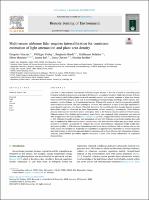| dc.contributor.author | Maurent, Eliott | |
| dc.contributor.author | y siete autores más | |
| dc.date.accessioned | 2023-01-18T20:43:51Z | |
| dc.date.available | 2023-01-18T20:43:51Z | |
| dc.date.issued | 2023-03 | |
| dc.identifier.uri | https://repositorio.catie.ac.cr/handle/11554/12229 | |
| dc.description.abstract | Leaf area is a key structural characteristic of forest canopies because of the role of leaves in controlling many biological and physical processes occurring at the biosphere-atmosphere transition. High pulse density Airborne Laser Scanning (ALS) holds promise to provide spatially resolved and accurate estimates of plant area density (PAD) in forested landscapes, a key step in understanding forest functioning: phenology, carbon uptake, transpiration, radiative balance etc. Inconsistencies between different ALS sensors is a barrier to generating globally harmonised PAD estimates. The basic assumption on which PAD estimation is based is that light attenuation is proportional to vegetation area density. This study shows that the recorded extinction strongly depends on target detectability which is influenced by laser characteristics (power, sensitivity, wavelength). Three different airborne laser scanners were flown over a wet tropical forest at the Paracou research station in French Guiana. Different sensors, flight heights and transmitted power levels were compared. Light attenuation was retrieved with an open source ray-tracing code (http://amapvox.org). Direct comparison revealed marked differences (up-to 25% difference in profile-averaged light attenuation rate and 50% difference at particular heights) that could only be explained by differences in scanner characteristics. We show how bias which may occur under various acquisition conditions can generally be mitigated by a sensor intercalibration. Alignment of light weight lidar attenuation profiles to ALS reference attenuation profiles is not always satisfactory and we discuss what are the likely sources of discrepancies. Neglecting the dependency of apparent light attenuation on scanner properties may lead to biases in estimated vegetation density commensurate to those affecting light attenuation estimates. Applying intercalibration procedures supports estimation of plant area density independent of acquisition characteristics. | es_ES |
| dc.format.extent | 14 páginas | es_ES |
| dc.language.iso | en | es_ES |
| dc.publisher | Elsevier | es_ES |
| dc.relation.ispartof | Remote Sensing of Environment | es_ES |
| dc.relation.uri | https://doi.org/10.1016/j.rse.2022.113442 | es_ES |
| dc.subject | BOSQUES | es_ES |
| dc.subject | FORESTS | es_ES |
| dc.subject | AIRBORNE LASER SCANNING | es_ES |
| dc.subject | ESCANEO LÁSER AEROTRANSPORTADO | es_ES |
| dc.subject | ALS | es_ES |
| dc.subject | PLANT AREA DENSITY | es_ES |
| dc.subject | DENSIDAD DEL ÁREA DE LA PLANTA | es_ES |
| dc.subject | PAD | es_ES |
| dc.subject | LAD | es_ES |
| dc.subject.other | Oficina Nacional Guatemala | es_ES |
| dc.title | Multi-sensor airborne lidar requires intercalibration for consistent estimation of light attenuation and plant area density | es_ES |
| dc.type | Artículo | es_ES |
| dc.identifier.status | restrictedAccess | es_ES |


